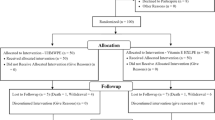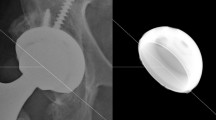Abstract
Introduction
An acetabular liner thickness of around 6 mm remains the “gold standard” in total hip arthroplasty. Some surgeons have been recommending the use of the thickest possible liner because contact stress and strain in articulating surfaces decrease with increasing the wall thickness. The purpose of this study was to determine whether in vivo creep and wear performance could be enhanced using a thicker liner over the standard thickness in vitamin-E-diffused highly crosslinked polyethylene (HXLPE).
Materials and methods
One hundred and twenty-two hips were allocated to age-matched, sex-matched, and body mass index-matched two subgroups implanted either with a 6.8- or 8.9-mm-thick vitamin-E-diffused HXLPE liner against 28-mm cobalt-chrome femoral head, and followed-up for 7 years. Linear and volumetric penetration of femoral head into the liners attributed to creep and wear were analyzed for each group.
Results
Compressive creep strain generated at the initial 6 months was significantly larger in the 6.8-mm group (2.6%) than in the 8.9-mm group (2.2%). The linear steady-state wear observed after 2 years was 0.0019 and 0.0015 mm/year, whereas the volumetric steady-state wear was 0.54 and 0.45 mm3/years in the 6.8- and 8.9-mm-thick groups, respectively. Although less strain in the thicker group resulted in a slightly less wear, it did not reach significant differences in the steady-state wear rates between the groups.
Conclusion
No clinical significance for using a thicker liner over the standard thickness (6.8 mm → 8.9 mm) was confirmed in the vitamin-E-diffused HXLPE according to the 7-year follow-up. The wear rates for both thicknesses were very low enough to prevent osteolysis, and no mechanical failure was observed at any follow-up interval. Nevertheless, since the significantly higher strain was seen in the thinner liner, further follow-up is needed to compare the longer term wear and the incidence of osteolysis and component fracture.





Similar content being viewed by others
Availability of data and materials
The data that support the findings of this study are available from the corresponding author upon reasonable request.
References
Khoshbin A, Wu J, Ward S, Melo LT, Schemitsch EH, Waddell JP, Atrey A (2020) Wear rates of XLPE nearly 50% lower than previously thought after adjusting for initial creep: an RCT comparing 4 bearing combinations. JB JS Open Access. 5(2):e0066
Nielson T, Owens G, Miller B, Meneghini E, Deckard ER, Meneghini RM (2022) Large femoral heads in total hip arthroplasty with vitamin E highly cross-linked polyethylene: head penetration rates compared to highly cross-linked polyethylene. J Arthroplast 37:S685–S691
Rochcongar G, Buia G, Bourroux E, Dunet J, Chapus V, Hulet C (2018) Creep and wear in vitamin E-infused highly cross-linked polyethylene cups for total hip arthroplasty: a prospective randomized controlled trial. J Bone Jt Surg Am 100:107–114
Matar HE, Platt SR, Board TN, Porter ML (2020) Overview of randomized controlled trials in primary total hip arthroplasty (34,020 Patients): what have we learnt? J Am Acad Orthop Surg Glob Res Rev 4(8):e20.00120
Shi J, Zhu W, Liang S, Li H, Li S (2021) Cross-linked versus conventional polyethylene for long-term clinical outcomes after total hip arthroplasty: a systematic review and meta-analysis. J Investig Surg 34(3):307–317
Prock-Gibbs H, Pumilia CA, Meckmongkol T, Lovejoy J, Mumith A, Coathup M (2021) Incidence of osteolysis and aseptic loosening following metal-on-highly cross-linked polyethylene hip arthroplasty: a systematic review of studies with up to 15-year follow-up. J Bone Jt Surg Am 103:728–740
Takahashi Y, Tateiwa T, Pezzotti G, Shishido T, Masaoka T, Yamamoto K (2016) Improved resistance to neck-liner impingement in second-generation highly crosslinked polyethylene—the role of vitamin E and crosslinks. J Arthroplast 31:2926–2932
Yamamoto K, Tateiwa T, Takahashi Y (2017) Vitamin E-stabilized highly crosslinked polyethylenes: the role and effectiveness in total hip arthroplasty. J Orthop Sci 22:384–390
Lambert B, Neut D, van der Veen HC, Bulstra SK (2019) Effects of vitamin E incorporation in polyethylene on oxidative degradation, wear rates, immune response, and infections in total joint arthroplasty: a review of the current literature. Int Orthop 43:1549–1557
Jameson SS, Lees D, James P, Serrano-Pedraza I, Partington PF, Muller SD, Meek RM, Reed MR (2011) Lower rates of dislocation with increased femoral head size after primary total hip replacement: a five-year analysis of NHS patients in England. J Bone Jt Surg Br 93:876–880
Sariali E, Lazennec JY, Khiami F, Catonné Y (2009) Mathematical evaluation of jumping distance in total hip arthroplasty: influence of abduction angle, femoral head offset, and head diameter. Acta Orthop 80:277–282
Bartel DL, Burstein AH, Toda MD, Edwards DL (1985) The effect of conformity and plastic thickness on contact stresses in metal-backed plastic implants. J Biomech Eng 107:193–199
Takahashi Y, Tateiwa T, Shishido T, Masaoka T, Kubo K, Yamamoto K (2016) Size and thickness effect on creep behavior in conventional and vitamin E-diffused highly crosslinked polyethylene for total hip arthroplasty. J Mech Behav Biomed Mater 62:399–406
Tateiwa T, Affatato S, Takahashi Y, Shishido T, Pezzotti G, Yamamoto K (2022) To what extent could the acetabular liner thickness be reduced yet remaining tribologically acceptable in metal-on-vitamin E-diffused crosslinked polyethylene hip arthroplasty? J Biomed Mater Res B Appl Biomater 110:2299–2309
Ong KL, Rundell S, Liepins I, Laurent R, Markel D, Kurtz SM (2009) Biomechanical modeling of acetabular component polyethylene stresses, fracture risk, and wear rate following press-fit implantation. J Orthop Res 27:1467–1472
Goebel P, Kluess D, Wieding J, Souffrant R, Heyer H, Sander M, Bader R (2013) The influence of head diameter and wall thickness on deformations of metallic acetabular press-fit cups and UHMWPE liners: a finite element analysis. J Orthop Sci 18:264–270
Kamada K, Takahashi Y, Tateiwa T, Shishido T, Masaoka T, Pezzotti G, Yamamoto K (2020) Influence of liner offset and locking mechanism on fatigue durability in highly cross-linked polyethylene total hip prostheses. J Biomed Mater Res B Appl Biomater 108:1993–2004
Langlois J, Hamadouche M (2023) What have we learned from 20 years of using highly crosslinked PE in total hip arthroplasty? Orthop Traumatol Surg Res 109:103457
Girard J (2015) Femoral head diameter considerations for primary total hip arthroplasty. Orthop Traumatol Surg Res 101:S25–S29
Oonishi H, Iwaki H, Kin N, Kushitani S, Murata N, Wakitani S, Imoto K (1998) The effects of polyethylene cup thickness on wear of total hip prostheses. J Mater Sci Mater Med 9:475–478
Ast MP, John TK, Labbisiere A, Robador N, Valle AG (2014) Fractures of a single design of highly cross-linked polyethylene acetabular liners: an analysis of voluntary reports to the United States Food and Drug Administration. J Arthroplast 29:1231–1235
Kabo JM, Gebhard JS, Loren G, Amstutz HC (1993) In vivo wear of polyethylene acetabular components. J Bone Jt Surg Br 75:254–258
Shen FW, Lu Z, McKellop HA (2011) Wear versus thickness and other features of 5-Mrad crosslinked UHMWPE acetabular liners. Clin Orthop Relat Res 469:395–404
Archard JF (1959) The temperature of rubbing surfaces. Wear 2:438–455
Shareghi B, Johanson PE, Kärrholm J (2017) Wear of vitamin E-infused highly cross-linked polyethylene at five years. J Bone Jt Surg Am 99:1447–1452
Salemyr M, Muren O, Ahl T, Bodén H, Chammout G, Stark A, Sköldenberg O (2015) Vitamin-E diffused highly cross-linked polyethylene liner compared to standard liners in total hip arthroplasty. A randomized, controlled trial. Int Orthop 39:1499–1505
Nebergall AK, Greene ME, Laursen MB, Nielsen PT, Malchau H, Troelsen A (2017) Vitamin E diffused highly cross-linked polyethylene in total hip arthroplasty at five years: a randomised controlled trial using radiostereometric analysis. Bone Jt J 99:577–584
Galea VP, Connelly JW, Shareghi B, Kärrholm J, Sköldenberg O, Salemyr M, Laursen MB, Muratoglu O, Bragdon C, Malchau H (2018) Evaluation of in vivo wear of vitamin E-diffused highly crosslinked polyethylene at five years: a multicentre radiostereometric analysis study. Bone Jt J 100:1592–1599
Lindalen E, Thoen PS, Nordsletten L, Høvik Ø, Röhrl SM (2019) Low wear rate at 6-year follow-up of vitamin E-infused cross-linked polyethylene: a randomised trial using 32- and 36-mm heads. Hip Int 29:355–362
Kjærgaard K, Ding M, Jensen C, Bragdon C, Malchau H, Andreasen CM, Ovesen O, Hofbauer C, Overgaard S (2020) Vitamin E-doped total hip arthroplasty liners show similar head penetration to highly cross-linked polyethylene at five years: a multi-arm randomized controlled trial. Bone Jt J 102:1303–1310
Thoen PS, Nordsletten L, Pripp AH, Röhrl SM (2020) Results of a randomized controlled trial with five-year radiostereometric analysis results of vitamin E-infused highly crosslinked versus moderately crosslinked polyethylene in reverse total hip arthroplasty. Bone Jt J 102:1646–1653
Bergvinsson H, Zampelis V, Sundberg M, Tjörnstrand J, Flivik G (2022) Vitamin E infused highly cross-linked cemented cups in total hip arthroplasty show good wear pattern and stabilize satisfactorily: a randomized, controlled RSA trial with 5-year follow-up. Acta Orthop 93:249–255
Galea VP, Rojanasopondist P, Laursen M, Muratoglu OK, Malchau H, Bragdon C (2019) Evaluation of vitamin E-diffused highly crosslinked polyethylene wear and porous titanium-coated shell stability: a seven-year randomized control trial using radiostereometric analysis. Bone Jt J 101:760–767
Dumbleton JH, Manley MT, Edidin AA (2002) A literature review of the association between wear rate and osteolysis in total hip arthroplasty. J Arthroplast 17:649–661
Bragdon CR, Martell JM, Greene ME, Estok DM 2nd, Thanner J, Kärrholm J, Harris WH, Malchau H (2006) Comparison of femoral head penetration using RSA and the Martell method. Clin Orthop Relat Res 448:52–57
Moore KD, Barrack RL, Sychterz CJ, Sawhney J, Yang AM, Engh CA (2000) The effect of weight-bearing on the radiographic measurement of the position of the femoral head after total hip arthroplasty. J Bone Jt Surg Am 82:62–69
Funding
No funding was provided directly to this study.
Author information
Authors and Affiliations
Corresponding author
Ethics declarations
Conflict of interest
The authors declared no potential conflicts of interest with respect to the research, authorship, and/or publication of this article.
Ethical approval
All procedures performed in studies involving human participants were in accordance with the ethical standards of the institutional and/or national research committee and with the 1964 Helsinki Declaration and its later amendments or comparable ethical standards. The study was approved by the Ethics Committee of our institution (No. T2020-0154).
Informed consent
All patients included in this study signed an informed consent.
Additional information
Publisher's Note
Springer Nature remains neutral with regard to jurisdictional claims in published maps and institutional affiliations.
Rights and permissions
Springer Nature or its licensor (e.g. a society or other partner) holds exclusive rights to this article under a publishing agreement with the author(s) or other rightsholder(s); author self-archiving of the accepted manuscript version of this article is solely governed by the terms of such publishing agreement and applicable law.
About this article
Cite this article
Matsuoka, T., Takahashi, Y., Ishida, T. et al. In vivo creep and wear performance of vitamin-E-diffused highly crosslinked polyethylene in total hip arthroplasty. Arch Orthop Trauma Surg 143, 7195–7203 (2023). https://doi.org/10.1007/s00402-023-04972-1
Received:
Accepted:
Published:
Issue Date:
DOI: https://doi.org/10.1007/s00402-023-04972-1




